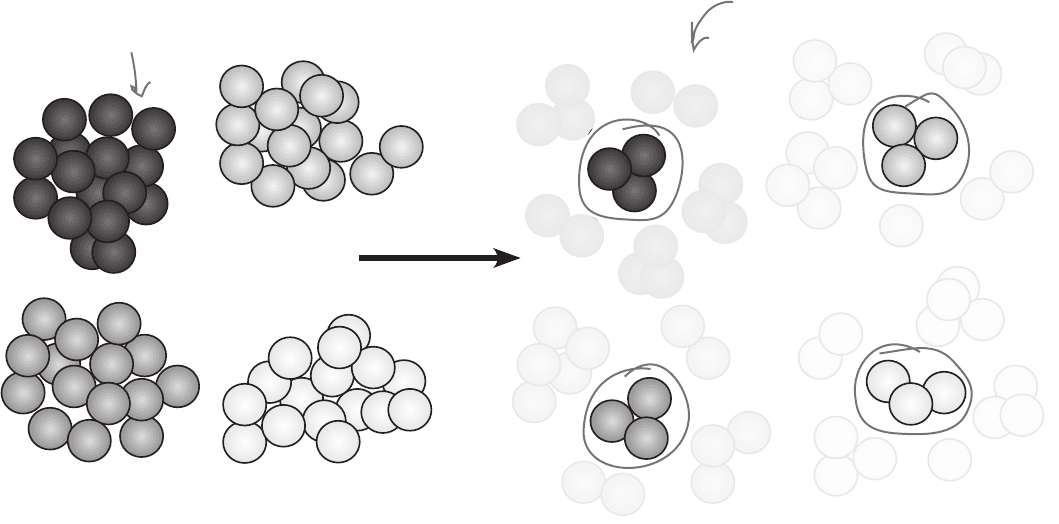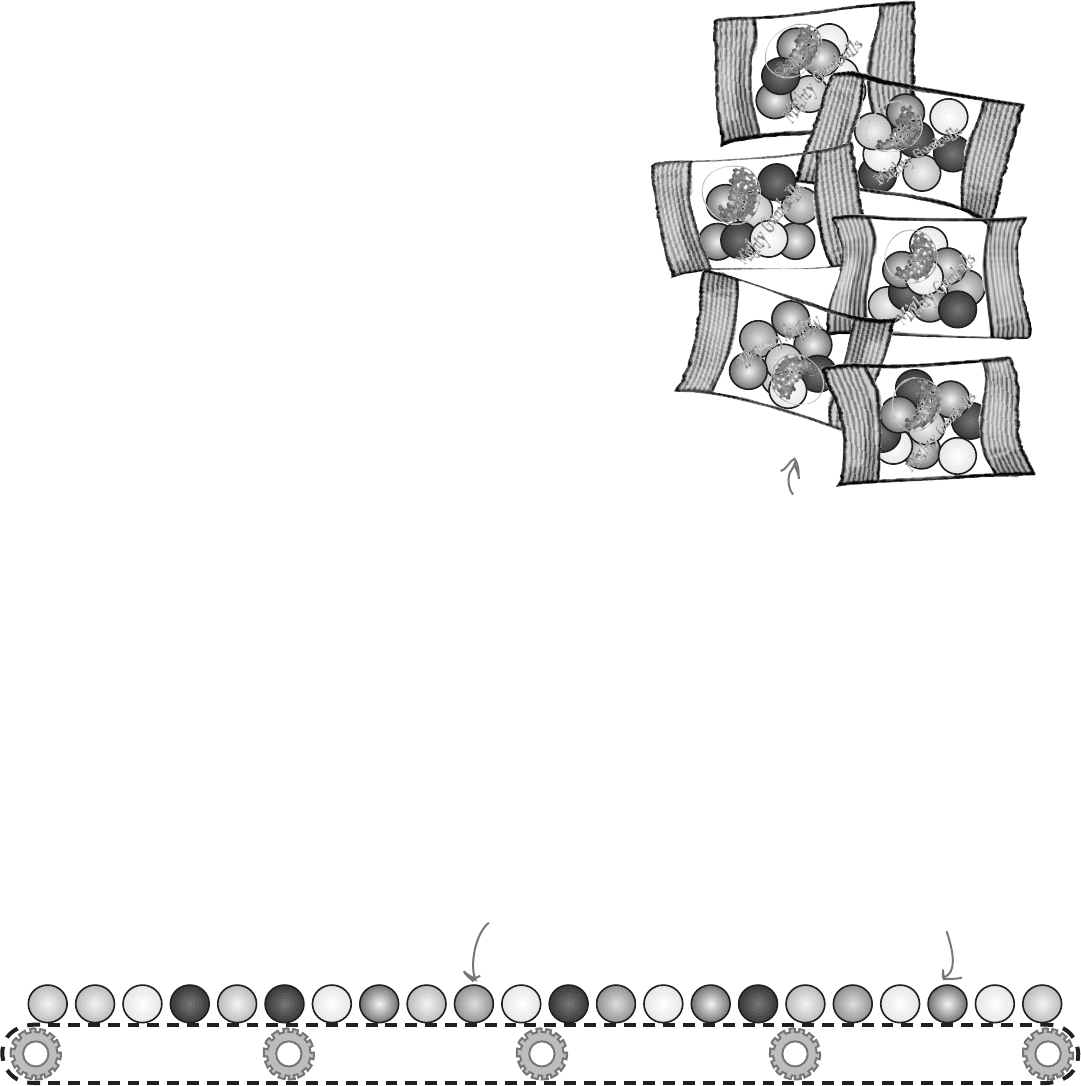Griffiths D. Head First Statistics
Подождите немного. Документ загружается.


you are here 4 431
using statistical sampling
How to choose a simple random sample
There are two main ways of using simple random sampling: by drawing lots or
using random numbers.
Drawing lots
Drawing lots is just like pulling names out of a hat. You write the
name or number of each member of the sampling frame on a piece
of paper or ball, and then place them all into a container. You then
draw out n names or numbers at random so that you have enough
for your sample.
Random number generators
If you have a large sampling frame, drawing lots might not be
practical, so an alternative is to use a random number generator,
or random number tables. For this, you give each member of the
sampling frame a number, generate a set of n random numbers,
and then pick the members of the set whose assigned numbers
correspond to the random numbers that were generated.
It’s important to make sure that each number has an equal chance
of occuring so that there’s no bias.
Simple random sampling isn’t without its problems. What do you think
could go wrong with it?

432 Chapter 10
There are other types of sampling
Even simple random sampling has its problems.
With simple random sampling, there’s still a chance that your sample will not
represent the target population. For example, you might end up randomly
drawing only yellow gumballs for your sample, and the other colors would be left
out.
So how can we avoid this?
We can use stratified sampling...
An alternative to simple random sampling is stratified sampling. With this type of
sampling, the population is split into similar groups that share similar characteristics.
These charateristics or groups are called strata, and each individual group is called
a stratum. As an example, we could split up the gumballs into the different colors,
yellow, green, red, and pink, so that each color forms a different stratum.
Once you’ve done this, you can perform simple random sampling on each stratum to
ensure that each group is represented in your overall sample. To do this, look at the
proportions of each stratum within the overall population and take a proportionate
number from each. As an example, if 50% of the gumballs that Mighty Gumball
produce are red, half of your sample should consist of red gumballs.
Each color is a
separate stratum.
We sample a proportionate
number from each stratum.
stratified, cluster, and systematic sampling

you are here 4 433
using statistical sampling
...or we can use cluster sampling...
Cluster sampling is useful if the population has a number of similar
groups or clusters. As an example, gumballs might be sold in packets,
with each packet containing a similar number of gumballs with similar
colors. Each packet would form a cluster.
With cluster sampling, instead of taking a simple random sample of
units, you draw a simple random sample of clusters, and then
survey everything within each of these clusters. As an example, you
could take a simple random sample of packets of gumballs, and then
taste all the gumballs in these packets.
Cluster sampling works because each cluster is similar to the others,
and an added advantage is that you don’t need a sampling frame of
the whole population in order to achieve it. As an example, if you were
surveying trees and used particular forests as your cluster, you would
only need to know about each tree within only the forests you’d selected.
The problem with cluster sampling is that it might not be entirely
random. As an example, it’s likely that all of the gumballs in a packet
will have been produced by the same factory. If there are differences
between the factories, you may not pick these up.
...or even systematic sampling
With systematic sampling, you list the population in some sort of order,
and then survey every kth item, where k is some number. As an example,
you could choose to sample every 10th gumball.
Systematic sampling is relatively quick and easy, but there’s one key
disadvantage. If there’s some sort of cyclic pattern in the population,
your sample will be biased. As an example, if gumballs are produced
such that every 10th gumball is red, you will end up only sampling red
gumballs, and this could lead to you drawing misleading conclusions
about your population.
Each packet forms a cluster.
You can pick every 10th gumball to get a systematic sample.

434 Chapter 10
Q:
Does using one of these methods
of sampling guarantee that the sample
won’t be biased?
A: They don’t guarantee that the sample
won’t be biased, but they do minimize the
chances of this happening. By really thinking
about your target population and how you
can make your sample representative of it,
you stand a much better chance of coming
up with an unbiased, representative sample.
Q:
Do I have to use any of these
methods? Can’t I just choose items at
random.
A: Choosing items at random is simple
random sampling. Yes, this is one approach
you can take, but one thing to be aware of is
that there is a chance your sample will not
be representative of the population at large.
Q:
But why? Surely if I choose items
at random, then my sample is bound to
be representative of the target population.
A: Not necessarily. You see, if you choose
sampling units at random, then there’s a
chance that purely at random, you could
choose a sample that doesn’t effectively
represent the target population. As an
example, if you choose customers of the
Statsville Health Club completely at random,
there’s a chance that you might choose only
attendees of one particular class, or of one
particular gender.
There might also be a case where you think
you’re sampling at random, when really
you’re not. As an example, if you conduct a
survey to find out customer satisfaction, but
leave it up to customers whether or not they
respond, you may well end up with a biased
sample as customers have to be sufficiently
motivated to respond. The customers who
are most motivated to take part in the survey
will be those who are either strongly satisfied
or strongly dissatisfied. You are less likely to
hear from those customers without strong
feelings, yet those people may make up the
bulk of the population.
Q:
How about if I just increase the size
of my sample? Will that get around bias?
A: The larger your sample, the less
chance there is of your sample being
biased, and this is one way of minimizing the
chances of getting a biased sample using
simple random sampling. The trouble is, the
larger your sample, the more cumbersome
and time-consuming it can be to gather data.
Q:
What’s the difference between
stratified sampling and clustered
sampling?
A: With stratified sampling, you divide
the population into different groups or strata,
where all the units within a stratum are as
similar to each other as possible. In other
words, you take some characteristic or
property such as gender, and use this as the
basis for the strata. Once you’ve split the
population into strata, you perform simple
random sampling on each stratum.
With clustered sampling, your aim is to
divide the population into clusters, trying to
make the clusters as alike as possible. You
then use simple random sampling to choose
clusters, and then sample everything in
those clusters.
Q:
I see. So with stratified sampling,
you make each stratum as different as
possible, and with clustered sampling,
you make each cluster as similar as
possible.
A: Exactly.
Q:
So what about systematic
sampling?
A: With systematic sampling, you choose
a number, k, and then choose every kth
item for your sample. This way of sampling
is fairly quick and easy, but it doesn’t mean
that your sample will be representative of
the population. In fact, this sort of sampling
can only be used effectively if there are no
repetitive patterns or organization in the
sampling frame
Q:
Drawing lots sounds antiquated.
Do people still do that?
A: It’s not as common as it used to be,
but it’s still a way of sampling.
there are no dumb questions

you are here 4 435
using statistical sampling
1. How could you apply simple random sampling to this problem?
2. How could you apply stratified sampling?
3. What about cluster sampling?
You’ve been given 10 boxes of chocolates and been asked to sample the chocolates in them.
There are whilte, milk, and dark chocolates in the boxes. Your target population is all of the
chocolates, and the sampling unit is one chocolate.

436 Chapter 10
1. How could you apply simple random sampling to this problem?
2. How could you apply stratified sampling?
3. What about cluster sampling?
You’ve been given 10 boxes of chocolates and been asked to sample the chocolates in them.
There are whilte, milk, and dark chocolates in the boxes. Your target population is all of the
chocolates, and the sampling unit is one chocolate.
You could apply simple random sampling by choosing chocolates at random, either through drawing
lots or using random numbers. That way, each chocolate stands an equal chance of being sampled.
For stratified smpling, you divide the chocolates into strata and apply simple random sampling to
each one. Each strata comprises of a group of chocolates with similar characteristics, so you could
use the different types of chocolate. One stratum could be white chocolates, another one could be
milk chocolates, and the final one could be dark chocolates.
For cluster sampling, you divide the chocolates into groups, but this time each group needs to be
similar. Assuming each box of chocolates is similar, you could take one of the boxes, and sample all of
the chocolates in it.
exercise solution

you are here 4 437
using statistical sampling
How would you go about conducting a sample survey of Mighty Gumball’s super-long-lasting
gumballs? The gumballs come in four different colors, and they’re all made in the same factory.
Assume you have to start your sample from scratch.

438 Chapter 10
How would you go about conducting a sample survey of Mighty Gumball’s super-long-lasting
gumballs? The gumballs come in four different colors, and they’re all made in the same factory.
Assume you have to start your sample from scratch.
A population is the entire collection
of things you are studying.
A sample is a relatively small
selection taken from the population
that you can use to draw conclusions
about the population itself.
To take a sample, start off by defining
your target population, the population
you want to study. Then decide on
your sampling units, the sorts of
things you need to sample. Once
you’ve done that, draw up a sampling
frame, a list of all the sampling units
in your target population.
A sample is biased if it isn’t
representative of your target
population.
Simple random sampling is where
you choose sampling units at random
to form your sample. This can be
with or without replacement. You can
perform simple random sampling by
drawing lots or using random number
generators.
Stratified sampling is where you
divide the population into groups of
similar units or strata. Each stratum
is as different from the others as
possible. Once you’ve done this, you
perform simple random sampling
within each stratum.
Cluster sampling is where you
divide the population into clusters
where each cluster is as similar
to the others as possible. You use
simple random sampling to choose
a selection of clusters. You then
sample every unit in these clusters.
Systematic sampling is where you
choose a number, k, and sample
every kth unit.
The target population is all of Mighty Gumball’s super-long-lasting gumballs, and the sampling unit is an
individual gumball. For the sampling frame, we ideally need some sort of numbered list of the gumballs, but
it’s likely that this isn’t practical. Instead, we’ll settle for a list showing how many gumballs there are in the
population for each color.
The type of sampling you use is subjective, but we’d choose to use stratified sampling, as this may be the best
way of coming up with an unbiased sample. We’d divide the gumballs into their different colors and then use
simple random sampling to choose a proportionate number of each of the four colors. We would then use these
for our sample.
Don’t worry if you got a different answer. The key thing is to think through how you can best make your
survey representative of the population, and you may have different ideas.
exercise solution

you are here 4 439
using statistical sampling
Mighty Gumball has a sample
With your help, Mighty Gumball has gathered a sample of their
super-long-lasting gumballs. This means that rather than perform
taste tests on the entire gumball population, they can use their
sample instead.
That’s great! It
means we’ll save time,
money, and teeth.
So what’s next?
We’ve looked at how we can put together a representative sample,
but what we haven’t looked at is how we can use it. We know that
an unbiased sample shares the same characteristics as its parent
population, but what’s the best way of analyzing this?
Keep reading, and we’ll show you how in the next chapter.
